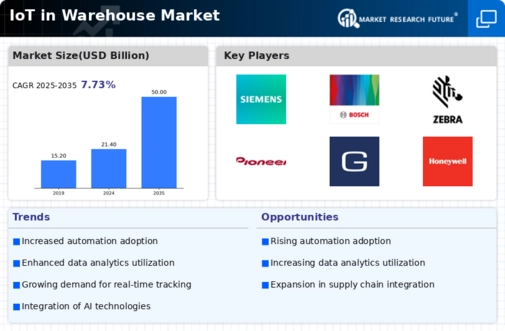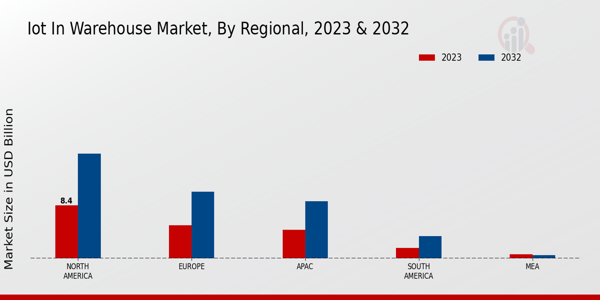Rising E-commerce Sector
The Global IoT in Warehouse Market Industry is significantly influenced by the rapid growth of the e-commerce sector. As online shopping continues to expand, warehouses must adapt to increased demand for faster order fulfillment and efficient inventory management. IoT technologies, such as smart shelving and automated picking systems, play a pivotal role in enhancing warehouse operations to meet these demands. The integration of IoT solutions allows for real-time inventory tracking and improved order processing times. This trend indicates that the market is likely to experience a compound annual growth rate (CAGR) of 8.01% from 2025 to 2035, driven by the need for agile and responsive warehousing solutions.
Market Growth Projections
The Global IoT in Warehouse Market Industry is poised for substantial growth, with projections indicating a market value of 50.0 USD Billion by 2035. This growth is underpinned by the increasing adoption of IoT technologies across various sectors, enhancing operational efficiency and supply chain management. The anticipated compound annual growth rate (CAGR) of 8.01% from 2025 to 2035 reflects the growing recognition of IoT's potential to transform warehouse operations. As businesses continue to invest in smart technologies, the market is likely to witness significant advancements in automation, data analytics, and connectivity, shaping the future of warehousing.
Sustainability Initiatives
The Global IoT in Warehouse Market Industry is increasingly aligned with sustainability initiatives as companies strive to reduce their environmental impact. IoT technologies facilitate energy management and waste reduction in warehouse operations. For example, smart lighting systems can adjust based on occupancy, leading to significant energy savings. Additionally, IoT-enabled monitoring systems can optimize resource usage, contributing to more sustainable practices. As sustainability becomes a priority for businesses, the demand for IoT solutions that support these initiatives is likely to grow. This trend indicates a broader shift towards eco-friendly operations within the warehousing sector, further driving market expansion.
Increased Demand for Automation
The Global IoT in Warehouse Market Industry experiences heightened demand for automation solutions, driven by the need for operational efficiency and cost reduction. Automation technologies, such as autonomous mobile robots and automated storage and retrieval systems, streamline warehouse operations, reducing labor costs and improving accuracy. In 2024, the market is projected to reach 21.4 USD Billion, indicating a robust growth trajectory. Companies are increasingly adopting IoT-enabled automation to enhance inventory management and order fulfillment processes, thereby optimizing supply chain performance. This trend suggests a shift towards smart warehouses that leverage IoT technologies to facilitate real-time data exchange and decision-making.
Enhanced Supply Chain Visibility
The Global IoT in Warehouse Market Industry benefits from enhanced supply chain visibility, which is crucial for effective inventory management and logistics operations. IoT devices, such as RFID tags and sensors, provide real-time tracking of goods throughout the supply chain. This visibility enables companies to monitor inventory levels, reduce stockouts, and minimize excess inventory. As organizations increasingly recognize the importance of transparency in their supply chains, the market is expected to grow significantly. By 2035, the market could reach 50.0 USD Billion, reflecting the growing reliance on IoT solutions to improve operational efficiency and customer satisfaction.
Cost Reduction through IoT Implementation
The Global IoT in Warehouse Market Industry is characterized by the potential for significant cost reductions through the implementation of IoT technologies. By automating processes and utilizing data analytics, companies can optimize their operations, leading to lower operational costs. For instance, predictive maintenance enabled by IoT sensors can reduce equipment downtime, thereby enhancing productivity. As organizations seek to improve their bottom line, the adoption of IoT solutions becomes increasingly attractive. This trend is expected to contribute to the market's growth, with projections indicating a market value of 21.4 USD Billion in 2024, as businesses recognize the financial benefits of IoT integration.
























